How to Effectively Use an Information Radiator in Agile
Rumyana Duncheva
Most teams struggle to access relevant important information quickly. As a result, key points are lost, team performance decreases, and value is missing. A lack of clarity leads to inefficiencies and delays in delivery which you can’t afford.
For an organization to work smoothly and provide value, information is essential. If teams don’t know what’s going on and what’s important, they won’t be able to focus on the right tasks and do their job properly.
For an organization to work smoothly and provide value, information is essential. If teams don’t know what’s going on and what’s important, they won’t be able to focus on the right tasks and do their job properly.
You can get your important information out in the open with information radiators. Agile and Lean methodologies use these radiators to support better visibility and efficiency. If you think your organization needs better information sharing, these tools might be what you need.
Information Radiators Explained
Information radiators are a way to visually represent important information, making it easily accessible and visible to all team members and stakeholders.
In 2001, Alistair Cockburn, one of the signatories of the Agile Manifesto, introduced the term information radiators in his book Agile Software Development. He noted that in order to adequately manage our projects, it would help to be able to see what was going on.
“With information radiators, the passersby don’t need to ask questions; the information simply hits them as they pass.” - Alistair Cockburn
The information radiator is openly shared and the content can be comprehended with just a quick glance. The sole purpose of this tool is to provide relevant visualization so teams understand what’s going on and focus on the workflow.
Problems Information Radiators Solve
Useful information radiators are helpful to align and visualize the decision-making and problem-solving process. This can save a lot of trouble for your team and organization. Let’s see what problem you can solve by using information radiators.

People and teams are underinformed
Teams tend to be underinformed. Often, they don't know everything that's going on, what decisions are being made, or what's coming up next.
All types of valuable information that would make us better judges of situations and options that we have available is missing. Visibility is crucial to effectively communicating key information to the team.
To be worth it, the information on the radiator must be precise and accurate. No one can work with irrelevant or inaccurate data. Otherwise, the team is in the dark about the most important pieces of work, leading to confusion and ineffectiveness. In this case, the value and benefits of the tool are lost and you might as well not have an information radiator.
People are not focused
People are overloaded, confused, and have lots of different things demanding their attention. The whole purpose of information radiators is to ensure key information is openly shared with everyone. Complex projects can be broken down into visual pieces that are simple to understand and act on. Now, people can focus on what’s important and get work done.
Too much happening at once to keep track
Often, too many things are happening at once in the workplace. It’s impossible for teams to be constantly concentrated on everything. It’s not how the human brain works. So it helps to have information radiators that can help you keep track and prioritize relevant work.
Humans are cats, alignment is fleeting
Human beings are like cats. We tend to get into a meeting, we make a decision, and then as the meeting goes through, we drift.
We have different memories of what the meeting was, what we decided, how we discussed it, who was supposed to do what. And when we forget, we replace that forget space with plausible stories that we tell ourselves about how the meeting went.
We have different memories of what the meeting was, what we decided, how we discussed it, who was supposed to do what. And when we forget, we replace that forget space with plausible stories that we tell ourselves about how the meeting went.
So then when we get together, not surprisingly, everybody has different ideas about what we decided and what's going on. This is why you need visual controls. You want to create a space where you can hold on to decisions that were made and not let the team members drift.
Decision-making is valuable. We want to save and extend the value of those decisions by using the artifacts of the meeting.
Common Information Radiator Formats
We’ve all probably used some kind of an information radiator without even realizing it. This includes any form of visualization - handwritten, drawn, printed, burndown, or velocity charts, as well as task boards, planning boards, and storyboards.
In addition, the rapid growth of the digital world has simplified the process of using information radiators to a simple click for remote teams and stakeholders.
The right format depends on the type and needs of the organization. No matter what you choose, make sure the information is precisely represented, regularly updated, and available to anyone who needs it.
Lean and Agile Information Radiators
There are all sorts of Lean visual controls and Agile information radiators like value stream maps, Kanban, Scrum boards, burn-down charts, and A3s. There are also many ways to create new ones through Agile games like the ones shown in Dave Gray’s Gamestorming and Luke Hohman’s Innovation games. All these are basically different ways to visualize work or a meeting so that people can see the decisions that you're making and align around them.
Having to constantly ask questions or search for important information is a frustrating waste of valuable time. All your tools should be accessible. Every team member and stakeholder should have quick access to the latest version of the information radiators.
Having to constantly ask questions or search for important information is a frustrating waste of valuable time. All your tools should be accessible. Every team member and stakeholder should have quick access to the latest version of the information radiators.
Which brings us to the Obeya.
Obeya
An Obeya is a room filled with information radiators. One place that stores all the information a team needs to be professional and get work done. This is where the team puts all of their information radiators. So now everyone knows where to go to get informed.
In general, everything in the Obeya is measured. Are we delivering quality? Are we making our deadlines? Is everybody doing what's expected of them? Are we missing anything?
When we go to work and don't know what's going on, we do two things - ask other people what's going on and imagine that we know what's going on.
We're running around interrupting other people asking questions. If a person's in a hurry, they'll tell you part of a story, you'll fill in the rest of it and that becomes your understanding of what's happening.
This creates uncertainty, fear, and doubt.
This creates uncertainty, fear, and doubt.
So if you don't have a lot of information about what's going on, your sense of agency is going to decline. As a result, you aren’t going to make decisions and act. Your sense of psychological safety is going to suffer and you aren’t going to feel like you are qualified or even allowed to raise issues.
Things Found in the Obeya
Unvisualized work is unprofessional work. When your team knows what’s happening, it acts with confidence. The Obeya holds crucial information the team needs to get their work done. Status, flow, expectations, calls to action, reassurance…all come from the Obeya.
The information radiators you put in your Obeya will be unique to your circumstances, but for the sake of illustration, here are several we’ve found useful.
Kanban Board
Agile teams can adapt the information radiator to match the framework they use. A great example and one of the most common information radiators is the Kanban board, which can be either physical or virtual.

The purpose is to visualize a team's process and work items that pass through it. The Kanban board can be used both on a personal or organizational level. The two main elements are the cards that represent the tasks and the columns that show their progress.
For example, the simplest way to name your columns and track the tasks’ path is by using the To-do; Doing; Done template. As each task progresses, the card is moved through the relevant column.
The Kanban board is shared with the team, providing transparency on what everyone is working on, how much is done, and what is blocked.
So this information radiator right now is showing that there is an unacceptable level of poorly done work and the team needs to stop and discuss it.
For example, the simplest way to name your columns and track the tasks’ path is by using the To-do; Doing; Done template. As each task progresses, the card is moved through the relevant column.
The Kanban board is shared with the team, providing transparency on what everyone is working on, how much is done, and what is blocked.
In this particular board, the kanban has been augmented to track how professionally satisfied the team is with their work. The DONE column has three sub-columns to track satisfied, okay, and dissatisfied states. In this way, the team is tracking both work they like to do and the quality of the work (professionals are usually unsatisfied with work they feel is substandard).
So this information radiator right now is showing that there is an unacceptable level of poorly done work and the team needs to stop and discuss it.
The Doominator
The Doominator is a popular tool for teams to see their defects and technical debt in context so they can make informed decisions about how to fix them. This information radiator is important. It’s created collaboratively, then drives future decisions. You have to be able to visualize your work in a value-driven context.
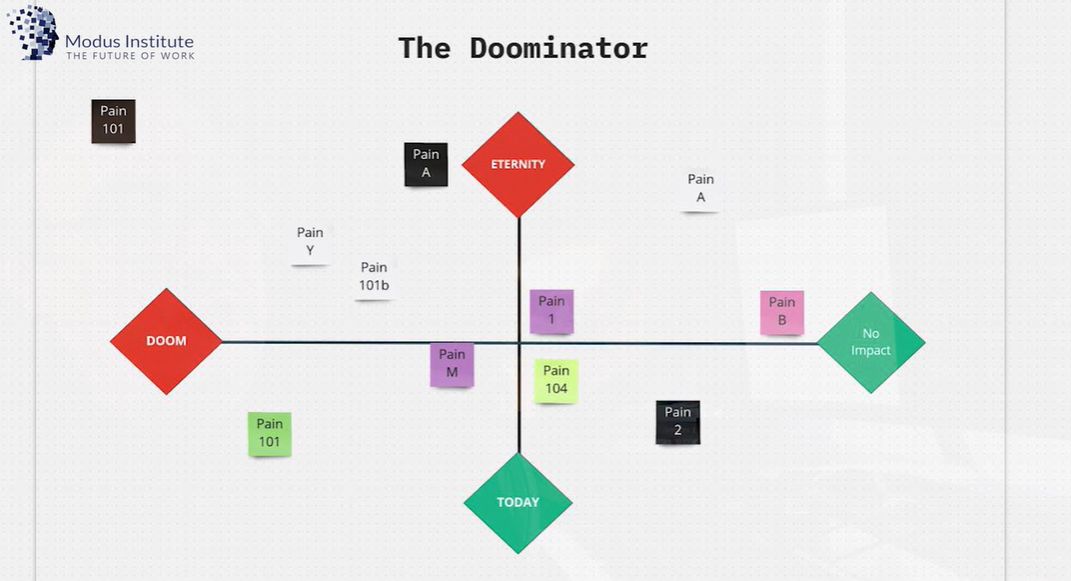
The Priority Filter
The Priority Filter is a visualization of three different levels of priority. This is an information radiator that reminds us to prioritize and allows work to happen in context.
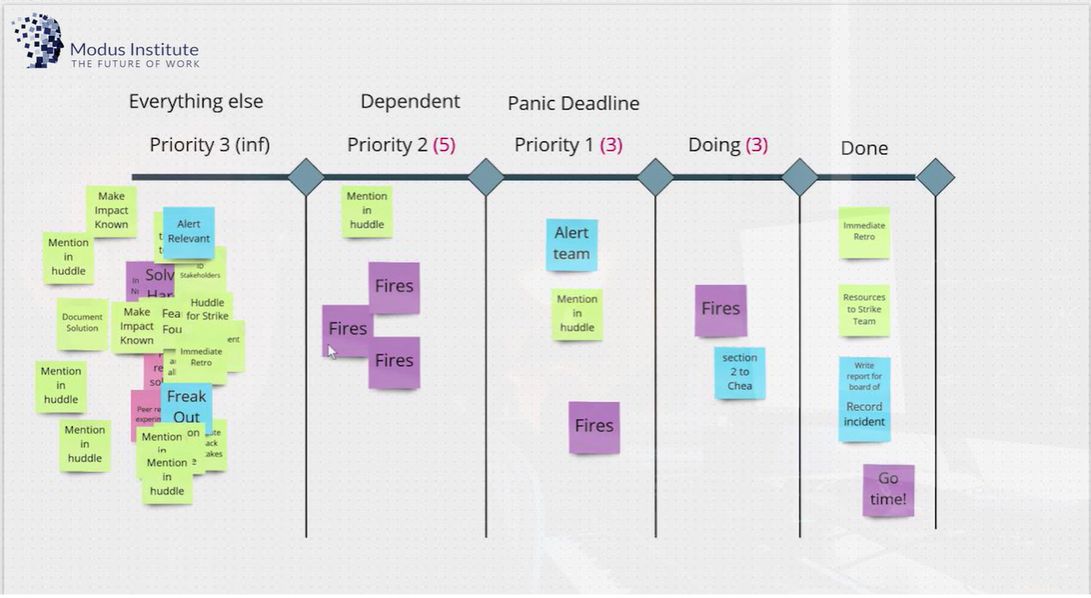
The Complexity Machine
Complexity surprises us every day in business. We treat it as an annoyance or someone’s fault. Information radiators help us see it.
With the Complexity Machine, we have four categories - complex, complicated, chaos, and clear. We drop each action item at the relevant place. We’re building these visual controls to solve a problem immediately and also to communicate later our decisions. So, we can move items from one category to another at any given time. This informational radiator shows us what work requires what level of effort.
With the Complexity Machine, we have four categories - complex, complicated, chaos, and clear. We drop each action item at the relevant place. We’re building these visual controls to solve a problem immediately and also to communicate later our decisions. So, we can move items from one category to another at any given time. This informational radiator shows us what work requires what level of effort.
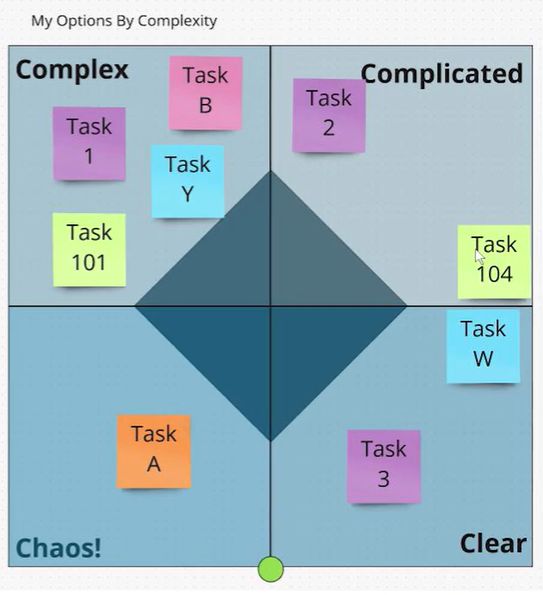
Seven Elements of Visual Management
Your team needs visual systems to quickly access the information they need so they can make effective decisions, complete the correct task at the right time, and continuously improve.
Visual management promotes productivity by highlighting process transparency and reducing unnecessary repeating queries. This requires the creation of an Obeya where all visualizations can be stored.
Whatever form of visualization you create, it must give relevant information to the individuals who need it when they need it, with little or no searching. In order to deliver value and serve its goal, the visualization should be clear, structured, and accessible for successful visual management.
Once you’ve got it down, you'll need to make sure your visualizations really do something. Let’s check the seven visualization components that professionals use to create effective information radiators.
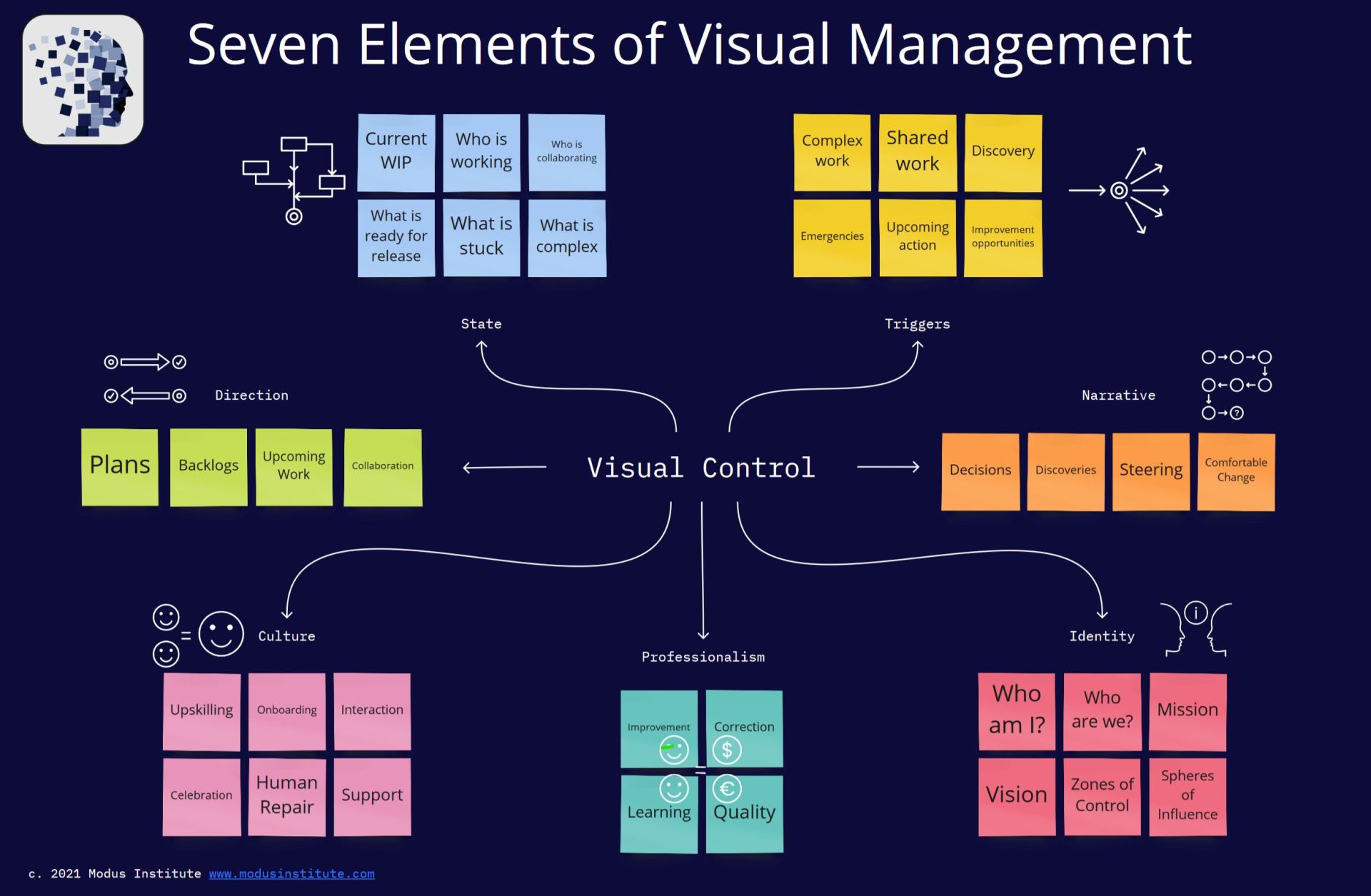
State
Almost every Kanban board shows the current state of the workflow. This is the simplest information with the highest need. Agile teams can lose track of state information so quickly that they ask people every single day what they are working on. Your visual system must show, in real-time, the state of whatever you are tracking. Think of that system as a channel for communication and collaboration.
Triggers
Work is more complex than we anticipate, problems and interruptions are around every corner. We recognize the call to act when triggers arise. We prepare and panic in response. Most visual systems overlook this aspect. The reasons are that the team hasn't talked about how they handle unforeseen work or emergencies, their visual controls aren't updated consistently and only show planned work.
All information radiators should include a call to action. If your visualization does not drive team members to take action, they won't use it in the first place. This is the primary communication task of any board. Each team member should be able to move through the board with confidence and ease.
All information radiators should include a call to action. If your visualization does not drive team members to take action, they won't use it in the first place. This is the primary communication task of any board. Each team member should be able to move through the board with confidence and ease.
Direction
The use of visual management removes the opportunity to take a wrong turn and add actions that don’t add value.
Your visualizations need to have a purpose and convey that to the people looking at them. This way, your team is moving in a coherent, known, and discussed direction.
Having immediate answers about where you're headed provides professionals with feedback on their actions, allowing them to picture what they'll do in the near future, and grounding their experimentation in things that are beneficial to finishing the tasks in progress.
Narrative
The information radiator shows us how change has happened, was dealt with, and reassures us that change isn’t something to fear.
In our visual management systems, narrative captures learning, improvement, or anything great that has occurred during the course of the project. This comes in handy when you need to explain why project modifications transpired to someone who wasn't involved.
If the project fails to visualize learning, the value will not only vanish, but may also become a liability. If we don’t professionally incorporate change, we remain amateurs scared of our own work.
Culture
Your culture is the engine that maintains the professionals on your team. Culture is almost never considered when creating a visual control and it is the number one reason they are often abandoned. Information radiators that don’t incorporate culture will always work against it.
If you don't see how you interact, you'll be bound to ignorance, assumptions, frustration, and distance. Visualization should stimulate and support team communication by clearly mapping the onboarding, support, upskilling, and collaboration processes.
Professionalism
Another main purpose of visual management is to reveal the bottlenecks that cry for improvement. Measuring and tracking via boards and systems will specify the information the team needs to improve. Visualizations must clearly show the relationship of work to quality and the improvement of that quality through shared learning by the entire team. That information must be used by the professionals quickly to keep it relevant and professionally invigorating. We know the work, the change, and how we can help. We see opportunities to add value and act.
Identity
Your visual controls should not be focusing exclusively on your work, but should always be looking at ways to share expertise with other groups and to collaborate with them when the work requires it. This way, the team knows who they are, where they are in the system, and how they can act or react in any given situation.

Wrap Up
Human and collaborative work has to run on visual systems because it helps us establish a shared narrative and get work done. Teams require real-time feedback. Agency, psychological safety, and good decisions run on this information.
The most important thing you should have in mind when using information radiators is to make them visible and accessible. That’s it! Going overboard is unnecessary, so be careful to avoid it. Keep things sweet and simple. When your team has the key information to help them prioritize and focus, that’s when the magic happens.
To make this all easier, we have a Visual Management Certification that breaks down the application of Lean and Agile practices and teaches you to build new ways of working. In it, you will build proficiency in a variety of practices that will allow you to respond to change, have a healthy working culture, and get quality work done quickly. This is the gateway to humane, productive, and professional working. We’ll be happy to guide you!
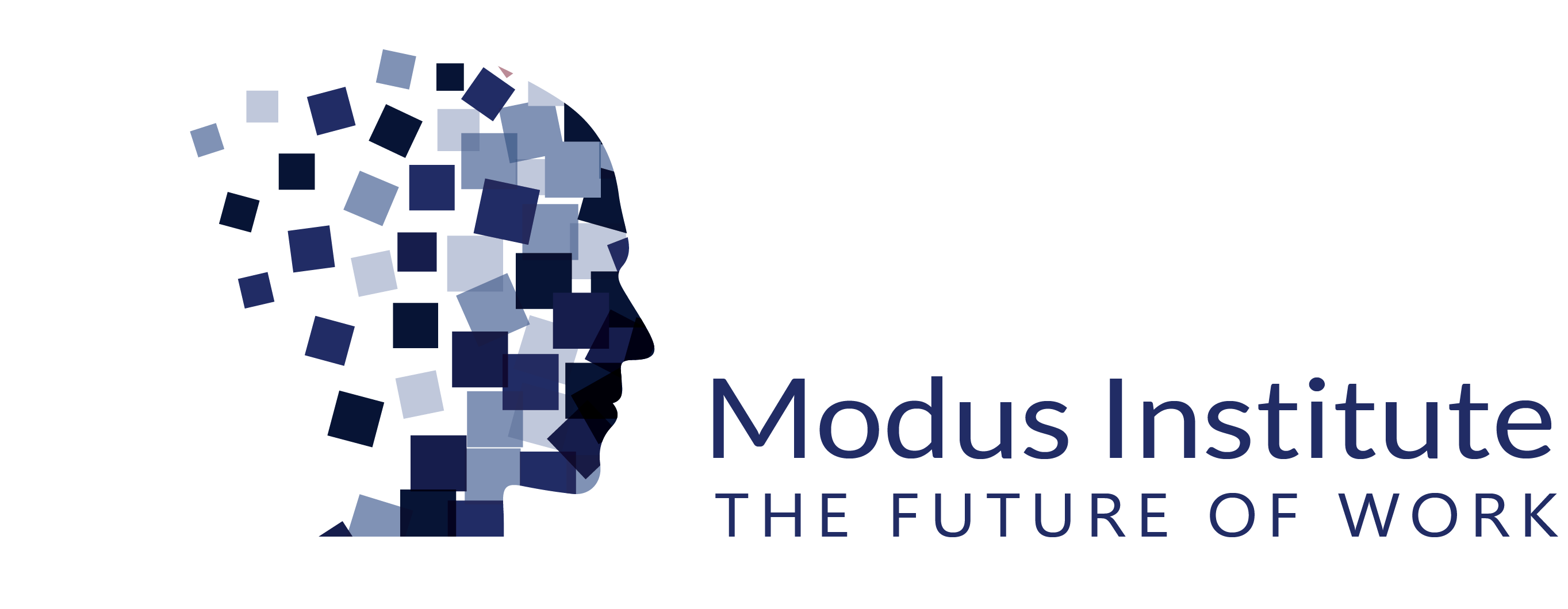
We are an online educational platform that helps professionals and aspiring individuals to succeed in their goals.
Copyright © 2025